I started playing Magic during the original Theros block, so I don’t feel the same sentimentality towards the hallowed plane of Dominaria that others might. Some players read old Dominaria cards with a sense of nostalgia; I view them with bemusement tinged with a strange mix of wonder, horror… and curiosity; holy cow there’s a card with javelin counters! That curiosity makes Dominaria Remastered weirdly appealing for a player like me: a curated set from across Magic’s history that eliminates the laughable chaff while preserving the quirks that made the older sets unique. How will the Limited format play out? Let’s take a look!
Mechanics and Themes
Cycling
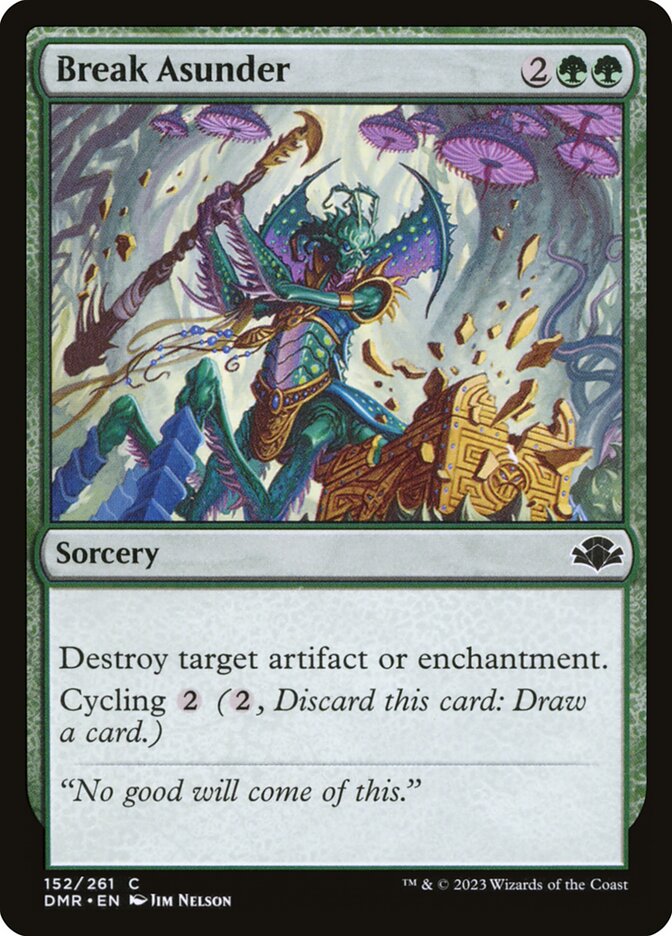

Cards with Cycling can be discarded along with a mana payment in order to draw a card. It’s a deceptively powerful ability that allows a deck to contain situational cards. Break Asunder is a good example; thanks to Cycling, it isn’t entirely dead even if the opponent doesn’t play artifacts or enchantments. Some Cycling cards such as Slice and Dice also have an additional effect if you cycle them.
Cycling cards are present in all five colors.
Madness


A Madness card like Obsessive Search can be cast when you discard it from your hand. When can you do that? Well, there are many enablers scattered throughout DMR that ask you to do precisely that for a beneficial effect. Undead Gladiator is one such card, giving you good value if you discard a Madness card to grab it from the graveyard.
Madness cards can be found in Blue and Black.
Threshold

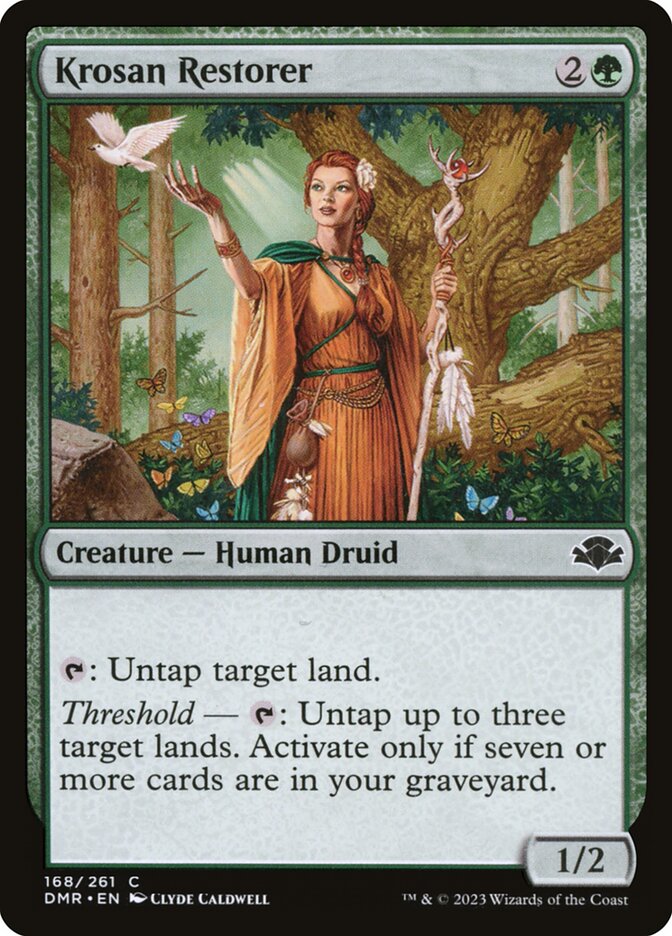
Threshold cards are pretty simple: fill up your graveyard and reap the benefits. These benefits vary greatly, from Vigilant Sentry’s stat boost and new ability to Krosan Restorer’s improved land untapping ability. The question then becomes how fast you can throw cards into your graveyard. The aforementioned Cycling cards and Madness enablers are great at doing so, as are any self-mill cards.
Threshold cards can be found in White and in Green.
Flashback
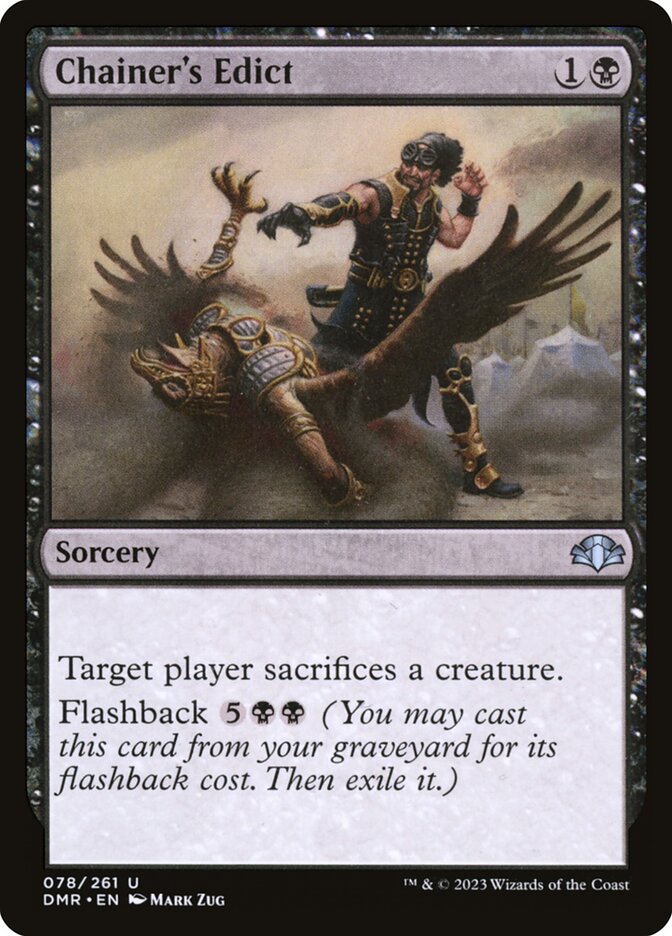

Flashback cards can be re-cast once from the graveyard, essentially making them two spells in one. Often the cost to recasting them is simply a greater mana cost, as with Chainer’s Edict; but sometimes the cost is a bit more esoteric, as with Battle Screech. Cards with Flashback are especially effective in sets with a graveyard theme, as they’ll feel great to self-mill or self-discard.
Flashback cards can be found in White, Blue, Black, and Green.
Split Cards

Split cards are two cards in one; you can cast either side, but not both. There’s no need to play both sides of the card; if you want the Elephant creation half of Assault // Battery, you can put the card in your deck even if you have no intention of casting Battery.
There are ten split cards in DMR representing each color pair.
And Don’t Forget…
DMR has a bunch of other mechanics that are only represented on a few cards. They’re not strongly supported, but I’ll list them here:
- Cumulative upkeep
- Echo
- Flanking
- Kicker
- Storm
Archetypes
Like all modern Limited sets, DMR features ten archetypes built around the ten color pairs, with a signature signpost uncommon for each.
White/Blue: “Enter the Battlefield” Value ( Midrange )



The signpost uncommon for a “value” archetype will probably disappoint players who have come to expect such creatures to simply draw cards. Not only does Sawtooth Loon fail to net you any cards; it also fails to net you board presence. So why is it good? Well, card selection is always great - but the true power is that it lets you reuse the “enter the battlefield” effects of your other creatures. Returning a creature to hand and then recasting it can be expensive though, which is why Momentary Blink is a premium common for this archetype. Peregrine Drake is okay as a free creature, but if you have five lands and blink it for two mana, then you suddenly have eight mana to play with for the rest of your turn.
White/Black: Lifeplay ( Midrange )



Mind Rot effects have long been fringe-playable at three mana in Limited, making the two mana Gerrard’s Verdict an intriguing card. Its potential life gain points towards White/Black’s true strategy though: the use of powerful but self-punishing cards such as Flesh Reaver that cause a constant loss of life, balanced with effects that gain you that life back like Spirit Link. Note that you have a limited amount of time to take advantage of your life payments before your opponent counters your strategy by simply playing expensive cards that outscale your board, so make sure you either win quickly or have ways to play a long game.
Blue/Black: Control ( Grind )



Recoil is a strange tempo card; it’s almost removal, but not quite. It exemplifies Blue/Black’s control strategy in DMR… which is not fast. Deep Analysis is essentially four cards for one - an exemplary rate - but this archetype’s true goal is to create value engines that make victory slow but inevitable. A creature like Urborg Syphon-Mage is important in such an engine, enabling your Madness cards while slowly draining your opponent out.
Blue/Red: Random… stuff… go! ( Grind )



Quicksilver Dagger is a confusing card; it’s clearly good, as it replaces itself immediately and represents free damage and cards on every successive turn. But what does it mean for the DMR archetype? Officially it’s Storm, and there are a plethora of “free” Blue cards such as Frantic Search that untap the lands used to cast them; combine that with Grapeshot (one of only two Storm cards in the set) and you can surprise your opponent with a fair amount of damage out of nowhere. I am somewhat skeptical that Storm cards are sufficient for victory though; more likely this Limited strategy needs to be supplemented with additional dribbles of damage. Take aggressive Red creatures, evasive Blue creatures - oh, and I guess that’s where Quicksilver Dagger comes into play.
Black/Red: Goblins ( Aggro )

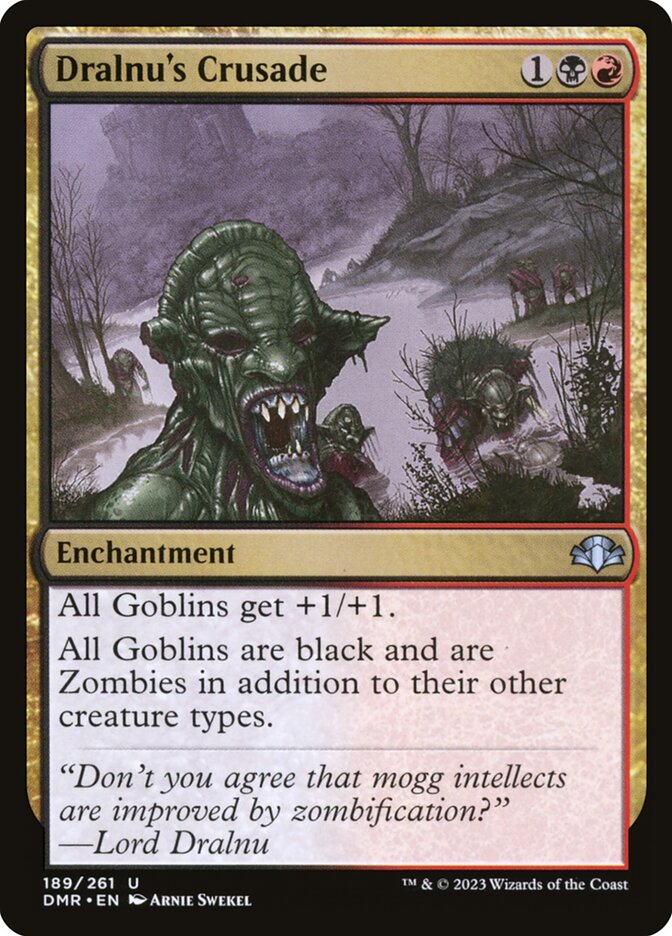

Some archetypes in DMR are a little muddy; that’s not the case for Black/Red. Dralnu’s Crusade makes it clear what this color pair cares about: goblins, goblins, and more goblins. Mogg War Marshal is excellent at creating a mini army to quickly overwhelm your opponent, especially if you have ways to pump your team. But what if the game drags out long and the opposing creatures start outclassing your own? That’s where a creature like Phyrexian Ghoul comes in. Although it’s not a goblin, it loves eating them up while making blocks very difficult for your opponent.
Black/Green: Uh ( Midrange )
[A good black card]  [A good green card]
[A good green card]
Spiritmonger is simply a powerful card: played with care, it’s nearly impossible to kill. Is it enough to draw me into Black/Green? I thiiiiiiink so, although I’ll feel a little dirty if my opponent plays a highly synergistic deck while I just try to play efficient creatures on curve (with removal to back them up). Does this color pair have a more defined strategy in DMR? You could mix Black sacrifice and self-discard with Green Threshold cards. Or you could just play the good cards in the colors; hey, sometimes Magic is a simple game.
Red/White: Auras ( Aggro )



The other aggro archetype in DMR is similarly straightforward: Tiana, Ship’s Caretaker cares about Auras and Equipment, and… there are no Equipment cards in the set, so Auras it is! Deploy cheap threats and buff them up with cards like Undying Rage (if you needed to block you probably weren’t going to win anyway). Creatures have a tragic tendency to pass away though, which is why Auramancer is a great card to include in order to recycle your Auras.
Red/Green: Cycling ( Midrange )
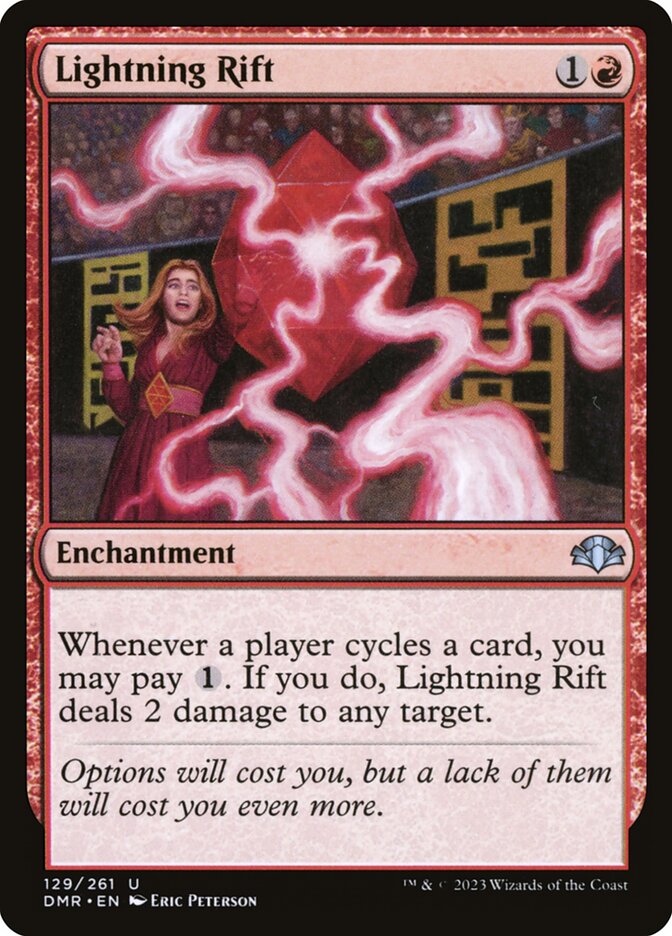


In many sets Red/Green is the aggressive mid-range color pair, and - yeah, that’s what it is in DMR. Radha, Heir to Keld is an inefficient mana dork that actually becomes pretty good if you can spend two red mana during combat at instant speed (since the mana she creates during combat disappears at the beginning of the second main phase). What mechanic supports that? Cycling! Cycling cards help this archetype find the right cards for the right situation, and if you have Lightning Rift or Invigorating Boon then Cycling becomes even stronger.
Green/White: Threshold ( Midrange )



It’s easy to see why Threshold is an attractive goal to reach: Mystic Enforcer is fine as a four mana 3/3, but incredible as a four mana 6/6 with flying. Similar things could be said about Werebear and Mystic Zealot, which makes the primary plan of this archetype pretty obvious. The trick is to find ways to load up your graveyard as fast as possible. Instants and sorceries, cheap creatures meant to die, Cycling cards; there’s a myriad of ways to do that. The key will be to find the most efficient way to do so.
Green/Blue: Ramp ( Midrange )



Players who drafted back in Dominaria will see Tatyova, Benthic Druid and either cheer in delight or groan in disgust; there’s no middle ground. This overpowered creature feels nearly unbeatable if one simply plays it and instantly drops a land. The trick is surviving to that point, and that’s often the quandary facing ramp decks: how do you survive long enough to play out your big threats? Well, you can simply generate a ton of mana unreasonably early in the game with High Tide, especially if you take advantage of Blue’s myriad land untapping effects. And what can you use that mana for? There aren’t many big creatures, but cards like Stonewood Invoker have expensive abilities ripe for use.
Mana Fixing
Let’s look at the non-land colorless mana fixing at common and uncommon:
It’s, uh, not a lot. There’s also a land which has the distinction of being a worse Evolving Wilds, which should tell you a lot about DMR:

There’s also a cycle of tri-lands that come into play untapped. They have an… interesting drawback:





Yep, playing a Lair means you’re setting yourself back a turn in your mana development. If you put these lands in your deck you’ll need to be super judicious in deciding when to play them, or risk falling behind and losing due to a self-inflicted wound.
As always, Green has a few added mana fixing options, but…


… Elvish Aberration only finds you a Forest (and there are no land cycling cards for the other colors), while Crop Rotation fixes your mana at the cost of a land. Note however that these drawbacks may actually be significant advantages; in a set with Threshold, spending one mana to throw two cards into the graveyard is incredibly good.
Key Commons and Uncommons
White:

- Pacifism: The original Pacifism effect returns as, uh, Pacifism.

- Nomad Decoy: Limited sets used to be filled with white cards that could tap creatures for a single mana. Then Wizards decided that the effect was too powerful. Play this card and you’ll see why.

- Swords to Plowshares: There’s a reason this card was never reprinted in a Modern-legal set.
Blue:

- Confiscate: No need to be jealous of your opponent’s bombs if you can just take them for yourself.

- Man-O’-War: The ultimate tempo play, it can be used on your opponent’s creatures or your own creatures. Even better if you find a way to use it multiple times!

- Peregrine Drake: Blue’s host of “free” spells in DMR culminates in this flyer. Do broken things with your lands, or just enjoy your virtually zero cost 2/3 evasive creature.
Black:

- Faceless Butcher: If you bounce this or blink this right after it enters the battlefield, you can exile an opponent’s creature permanently. If you can’t, it’s still not bad.

- Phyrexian Rager: Recently reprinted in Dominaria United, this creature remains a cute little nugget of value.

- Terror: It’s always good! Well, almost.
Red:

- Chain Lightning: This card has a real drawback, but there’s no guarantee that your opponent is playing red - and even if they are, patience will allow you to play around the possibility that they throw the lightning right back at you.

- Fireblast: This card finishes games.

- Flameongue Kavu: The original Ravenous Chupacabra retains its power. It’s even better in a set with blink and return-to-hand effects.
Green:

- Call of the Herd: Three mana for a 3/3 is not bad in modern Limited, and crazy good in older Limited sets. And being able to cast it again means that there will be games that end because one player has two elephants on turn four.

- Deadwood Treefolk: It’s a slow but steady way to buy some card advantage while also buying time with a big defense body on the ground.

- Squirrel Nest: A 1/1 every turn doesn’t sound like much, but it really builds up. Bonus points if you combine it with Blue’s untap land effects!
Colorless:

- Icy Manipulator: Those who have cast this artifact know how good it is; those who haven’t… just trust me. It’s good.
Summation
So what have we learned about Dominaria Remastered?
- DMR is nothing like recent Limited sets. The power level of individual cards is far lower; archetypes are far less defined; creatures and fixing are far less efficient.
- Most games will be slow and grindy until someone plays one of the few bomb uncommons or rares or mythics. Save your removal for those cards or risk losing on the spot.
- There will also be occasional flashes of EXTREME POWER when someone pulls out a busted play - High Tide with Blue’s land untapping effects, an insane blink chain, a turbo Threshold draw. Be wary of these combos while doing your best to build your own.
- There are a lot of X/1 creatures. Effects that deal one damage are very strong.
Good luck!










